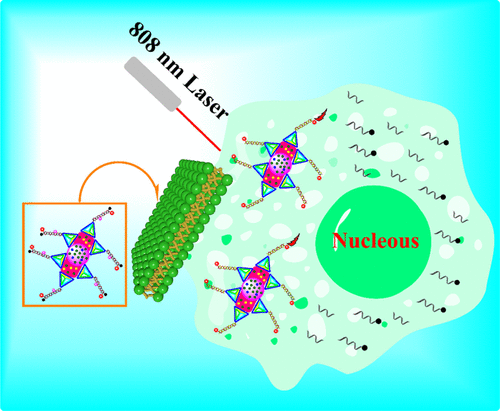Our official English website, www.x-mol.net, welcomes your
feedback! (Note: you will need to create a separate account there.)
Integrating 808 nm Light-Excited Upconversion Luminescence Powering with DNA Tetrahedron Protection: An Exceptionally Precise and Stable Nanomachine for Intracelluar MicroRNA Tracing.
ACS Sensors ( IF 8.2 ) Pub Date : 2019-12-23 , DOI: 10.1021/acssensors.9b02043 Cheng-Yu Li 1 , Bei Zheng 2 , Ya-Feng Kang 2 , Hong-Wu Tang 2 , Dai-Wen Pang 3
ACS Sensors ( IF 8.2 ) Pub Date : 2019-12-23 , DOI: 10.1021/acssensors.9b02043 Cheng-Yu Li 1 , Bei Zheng 2 , Ya-Feng Kang 2 , Hong-Wu Tang 2 , Dai-Wen Pang 3
Affiliation

|
Although plentiful advanced fluorescence sensors have achieved to analyze microRNAs (miRNAs) in living cells, the prerequisite relating to nucleic acids specific recognition based sensing principle compels them lack favorable accurancy and stability in such complicated biological mediums. Here, we make a double breakthrough for the two challenges by combining a near-infrared (NIR) light powering process with a DNA tetrahedron (DNAT)-based protection concept. In this sensing system, a special nanomachine is first engineered by conjugating a core-shell-structured upconversion nanoparticle capable of highly converting 808 nm NIR photons into ultraviolet ones with self-assembling DNATs. The newly developed nanostructure not only prevents the sensing pathway from triggering during the intracellular delivery as well as reducing the adverse thermal effect for cell viability but also significantly enhances the enzyme resistance to avoid degradation to produce false signals. Furthermore, a fluorescence resonance energy transfer sensing strategy is rationally designed on this nanomachine. Upon using the powering light to excite the upconversion luminescence to activate the nanomachine in living cells, it can stably trace the precise level changes of miRNA-21 sequences at the reaching position with an "off-on" mode of fluorescence outputs.
中文翻译:

集成808 nm光激发的上转换发光和DNA四面体保护功能:用于细胞内MicroRNA追踪的异常精确且稳定的纳米机。
尽管已经获得了很多先进的荧光传感器来分析活细胞中的microRNA(miRNA),但是基于核酸特异性识别的传感原理的先决条件迫使它们在如此复杂的生物介质中缺乏良好的准确性和稳定性。在这里,我们通过将近红外(NIR)发光过程与基于DNA四面体(DNAT)的保护概念相结合,为两个挑战做出了双重突破。在这种传感系统中,首先通过结合核壳结构的上转换纳米粒子来设计特殊的纳米机器,该纳米粒子能够通过自组装DNAT将808 nm NIR光子高度转化为紫外光子。新开发的纳米结构不仅可以防止传感途径在细胞内传递过程中触发,还可以减少对细胞活力的不利热效应,还可以显着增强酶的抵抗力,从而避免降解产生错误信号。此外,在该纳米机器上合理地设计了荧光共振能量转移感测策略。在使用强光激发上转换发光以激活活细胞中的纳米机器时,它可以通过“关”模式的荧光输出稳定地追踪到达位置的miRNA-21序列的精确水平变化。在此纳米机器上合理设计了荧光共振能量转移传感策略。在使用强光激发上转换发光以激活活细胞中的纳米机器时,它可以通过“关”模式的荧光输出稳定地追踪到达位置的miRNA-21序列的精确水平变化。在此纳米机器上合理设计了荧光共振能量转移传感策略。在使用强光激发上转换发光以激活活细胞中的纳米机器时,它可以通过“关”模式的荧光输出稳定地追踪到达位置的miRNA-21序列的精确水平变化。
更新日期:2019-12-25
中文翻译:

集成808 nm光激发的上转换发光和DNA四面体保护功能:用于细胞内MicroRNA追踪的异常精确且稳定的纳米机。
尽管已经获得了很多先进的荧光传感器来分析活细胞中的microRNA(miRNA),但是基于核酸特异性识别的传感原理的先决条件迫使它们在如此复杂的生物介质中缺乏良好的准确性和稳定性。在这里,我们通过将近红外(NIR)发光过程与基于DNA四面体(DNAT)的保护概念相结合,为两个挑战做出了双重突破。在这种传感系统中,首先通过结合核壳结构的上转换纳米粒子来设计特殊的纳米机器,该纳米粒子能够通过自组装DNAT将808 nm NIR光子高度转化为紫外光子。新开发的纳米结构不仅可以防止传感途径在细胞内传递过程中触发,还可以减少对细胞活力的不利热效应,还可以显着增强酶的抵抗力,从而避免降解产生错误信号。此外,在该纳米机器上合理地设计了荧光共振能量转移感测策略。在使用强光激发上转换发光以激活活细胞中的纳米机器时,它可以通过“关”模式的荧光输出稳定地追踪到达位置的miRNA-21序列的精确水平变化。在此纳米机器上合理设计了荧光共振能量转移传感策略。在使用强光激发上转换发光以激活活细胞中的纳米机器时,它可以通过“关”模式的荧光输出稳定地追踪到达位置的miRNA-21序列的精确水平变化。在此纳米机器上合理设计了荧光共振能量转移传感策略。在使用强光激发上转换发光以激活活细胞中的纳米机器时,它可以通过“关”模式的荧光输出稳定地追踪到达位置的miRNA-21序列的精确水平变化。











































 京公网安备 11010802027423号
京公网安备 11010802027423号